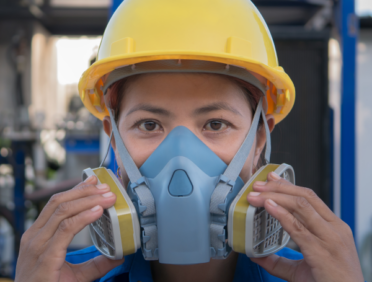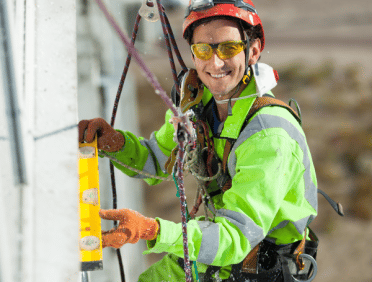Whilst there are risks that apply to many different industries and roles within them, it has to be said that from a health and safety point of view, some are more prone to accidents and incidents than others.
One example of this is those roles that require someone to work at height. But what is meant by working at height, and what regulations are in place to help to protect those who do this on a regular basis?
One of the simplest definitions of work at height can be found on the HSE website, and it states that work at height means that work is taking place where, if precautions were not taken, the person working could fall a distance that could then cause them injury.
Therefore, you can be considered to be working at height if you are working above the ground or floor level.
The Work at Height Regulations 2005
In 2005 the Work at Height Regulations was created. They were made because falls from height account for the majority of serious accidents (and even fatal accidents) in the workplace. Before these regulations were in force, it was thought that the health and safety regulations that concerned falls at work were not rigorous enough to deal with falls from a height.
The 2005 regulations were much more detailed in the requirements and measures that need to be taken by employers if they have employees working for them at height, whether that is all the time or some of the time.
Working at Height Policy and Procedure
Every workplace whereby there are going to be employees who work at height needs to ensure that they have policies and procedures in place. These should match with the Work at Height Regulations 2005.
It is important that all staff, whether they already work at height, are aware of these policies and understand their own responsibilities in ensuring that the regulations are met.
Employers also have to ensure that the work that is carried out is properly planned and supervised, as well as that those who work from heights have been properly trained and have the right skills and knowledge to enable them to work safely whilst they are at a height.
Safe use of ladders and stepladders
It is important to know that both ladders and stepladders are not banned under health and safety laws. However, the regulations state that any work on ladders should be approached in a way that is sensible and with appropriate risk management.
Ladders and stepladders should only be used as a short-term solution to working at height and they should never be the first choice approach to take.
In order to use a ladder or a stepladder, the person using it and those around them should understand what is the safe use of these pieces of equipment and be aware of the risks that can be posed by working at height.
This means that they should be provided with the right training in order to keep them safe, as well as how to check a ladder is safe before they are used.
It is also important to ensure that employees are aware of where ladders should be used, the types of ladders that are most appropriate to be used and how they can be secure and safe to be used too.
All of these things can come together to ensure that working on a ladder is as risk-free as possible.
What you must do as an employer
As an employer, the responsibility of keeping those working at height safely and following the regulations is down to you. This means that you need to be aware of what you must do as an employer.
There are a number of aspects of this that you should keep in mind.
Fragile surfaces
Working on a fragile surface is covered as a part of the Working at Height Regulation 2005. A fragile surface is defined as a surface which would be liable to fail if any reasonable loading were applied to it.
A person who was walking across this surface (even one that wasn’t carrying any tools or materials) could be classed as reasonable loading.
Working on a fragile surface can be dangerous, as there is a risk that it can give way, and the person can then fall a considerable height. It is important that any work on a fragile surface (such as a roof) is properly planned and organised so that those who are working on the surface are kept safe, especially in poor weather conditions or dangerous situations.”
Work on a fragile surface should be avoided as much as possible, however, if it is required, then it should be limited in time, and the work should be carried out underneath if it can be.
If the work cannot be taken on from underneath the surface, then a mobile elevating work platform can be used, which can allow people to work on the surface without putting any weight onto it.
In circumstances where the only way to work on the surface is to stand or walk on it, then safety nets should be installed underneath in order to keep the people working safely.
Another risk to working at height is that things may fall from the working space and possibly land on someone or something below the working area.
This can include hand-held tools, materials and also debris from work being carried out.
There are lots of ways that an employer can try to limit the chance of this happening. They can use a double-boarded platform for the workspace that has a polythene sheet in between the boards. This will stop smaller items from being able to fall through.
On scaffolding, brick guards and netting can also be used as this will stop the chance of materials falling through the side and off of the work area.
You also need to take into account how the weather can impact the chance of things falling off of platforms and work areas. If the weather is severe, such as there is a chance of high winds, then it may be the most sensible approach to stop the work and continue when the wind has calmed down.
Exceptions
There are some cases that may seem like they form a part of working at height, however, they are not. These exceptions include the following:
- Walking up and down stairs in an office
- Working in an office on the upper floors of a temporary building
- Sitting in a chair
- Work that is carried out by private individuals in their own home
Common work at height myths
Much like many regulations and guidelines, there are some common myths that are often associated with the Working at Height Regulations.
One common one is that the HSE has banned ladders from being used on building sites. This is definitely not the case. In fact, in many situations using a ladder or a stepladder can be a sensible choice for working at height. However, it is usually recommended that working on a ladder is only for a short term (for no more than 30 minutes at a time) and that the other risks associated with the work are low.
Another misconception that is often linked to working on a ladder at work is that you need to have a formal qualification to allow you to do this. The answer to this is that no, you do not need a formal qualification in order to work on a ladder. However, you do need to be seen to be competent to carry out the work. This means that you have the necessary skills and knowledge to use the ladder properly. If you are being trained, then you should be supervised by someone who has this knowledge and can help you to stay safe.
Some people also think that walking up and down a staircase at work could be seen as working at height. However, this is also not the case.
One final misconception is that when you are working on a stepladder, you need to have two feet and one hand on the ladder at all times. This is not true; in fact, there are going to be lots of situations when you are going to need to take your hands off of the stepladder in order to complete your task. This could be to install something above you or to put a box on a shelf. If you do need to take your hands off, then you should always have three points of contact with the stepladder (this is where the misconception comes from). However, these three points of contact can be two feet and your body; they do not have to relate to your hands so long as you are secure.
To download a .pdf of this blog, please click here












